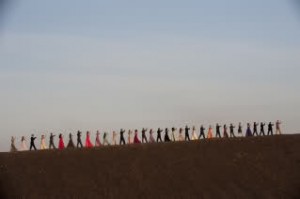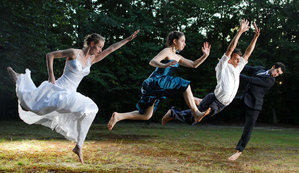Note to Spammers: I am a professional writer with more than 20 years experience. I write every single word that I upload onto my blog and use the blog as a repository for my published work. I would have no need to hire any writers especially at .01 cents per word. What sort of person would write for such peanuts? But you can hire me for $1.00 per word. Merilyn
Archive for February, 2012
A Lincoln dreamscape Painted Bride performance evokes his premonition of death.
Author: adminFeb 19
Posted: Mon, Feb. 13, 2012, 3:01 AM
By Merilyn Jackson
For The Inquirer
 P. BROWNING
P. BROWNING
David and Lindsay Browning, father and daughter, in the dance theater work “Lincoln Luck” at the Painted Bride. The mystical dream sequences have moments of clarity and beauty.
Abe Lincoln had an irksome dream he’d be assassinated just two weeks before he actually was. Dancer Lindsay Browning and her father, actor David Browning, collaborated in a dance theater work, inspired by the dream, titled Lincoln Luck which evoked a dreamlike atmosphere rather than a narrative.
It premiered at the Painted Bride over Lincoln’s birthday weekend with performances Friday and Saturday.
The audience entered through the cafe with David Browning, bearded and in Lincoln dress, inviting us to follow him into the theater. Of course it’s the theater where Lincoln goes to meet his end.
Lindsay Browning is there waiting onstage in a harness and hoop skirt with three long white trains trailing out in different directions. With one red-gloved hand, she waves the air before her, writhing within these confines like a woman possessed. She soon sets herself free and dances to Thomas Wave’s sitar, guitar, and organic sound environment.
The Painted Bride set included three long vertical rectangles for poetic video projections by Gaetan Spurgin. Tommy Burkel is the youngster walking in one, Myra Bazell dances in another. A third featured abstract images.
The lighting by Madison Cario infused the work with a mournful aura that also helped to create its ambiguity. This moody atmosphere sometimes overwhelmed the work, becoming more dominant than the meaning, which was hard to decipher. We were supposed to be viewing Lincoln as a 217-year-old dancing with an imagined daughter in 2026. This did not come through for me in the performance but was merely told to us by David Browning.
Nevertheless, if you took it as a mystical dream and just went with it, it had its moments of clarity and beauty.
When John Luna joins Lindsay Browning in a duet, they swing gold pocket watches on a chain together. Luna takes a walk to and fro, still swinging his watch by its fob, but it pulls him in the opposite direction each time. Is he supposed to be the young Lincoln and is time pulling him back?
David Browning’s soliloquies are lovely, notably the one where Lincoln speculates on what would have happened if he’d had a daughter: “A girl would’ve changed us,” he says, “to dance while bullets rang out.”
He is most charming when he carries in a birthday balloon and what looks like a birthday pie with candles that read 87.
He blows them out, bringing us back from the future to the present, and the lights go out.
A giant of dance, Joan Myers Brown, has a biographer to match
Author: adminFeb 16
By Merilyn Jackson
FOR THE INQUIRER
In her 80 years, Joan Myers Brown has been an artist, entrepreneur, and visionary, who with steely grace founded first, in 1960, a dance school for African American children and then, in 1970, Philadanco, where young dancers of color could find a performance home. It is now one of America’s most important companies, and one of Philadelphia’s most renowned touring exports.
The challenge of relating Brown’s life and accomplishments, of capturing her vitality, glamour and humanity, required someone her equal in beauty and wisdom. No one was better qualified than Brenda Dixon Gottschild – performer, groundbreaking author, and professor emerita of dance studies at Temple University, where she taught from 1982 until retiring in 1999.
How Dixon Gottschild came to write Joan Myers Brown & the Audacious Hope of the Black Ballerina: A Biohistory of American Performance, published last month by Palgrave Macmillan, is itself a compelling story, revealing the continuum made possible by the grit and determination of the author’s African American predecessors, including Brown and, before her, such teachers as Marion Cuyjet.
Like Brown, Dixon Gottschild has the stamina of a lioness and the heart of a mother, and navigates the murky waters of race politics with panache and originality. Her first book, Digging the Africanist Presence in American Performance (1996) traced Africanist movement in ballet and modern dance – “Balanchine’s Americanization of ballet if you will,” she gives as one example. After its publication, she recalled at a Philadelphia book signing last month, “I was invited to submit a proposal on my dissertation, which could not have been published when I wrote it in 1981 because no one wanted to publish anything about dance and race.”
Life Lessons from Pina and ‘Pina’
Author: adminFeb 14
February 9, 2012
By Merilyn Jackson
Few choreographers have the power to effect life-altering changes the way Pina Bausch did over the course of her 50-year career, and, even now, three years after her untimely death. That is what Pina does. She changes your life. She changed mine and she changed the lives of others I know. She altered my life so much, before and still long after I met her, that I have always felt touched, blessed, and saw my own work stretch to a level beyond what I had achieved. I’m even writing a poem about her effect called Pina, Queen of the Desert.
German filmmaker Wim Wenders in a recent NPR interview spoke about the first time he went to a performance by Bausch and her Tanztheater Wuppertal. “I found myself on the edge of my seat, crying like a baby after five minutes, and crying through the entire thing,” he recalled. “I was hopelessly, helplessly crying, and didn’t know what was happening. It was like lightning struck me.” The work? It was Café Müller, from 1985, and he says it changed his life.
Anyone who’s seen the film Pina (I have, three times, in previews in Philadelphia and New York) is struck with wonder, even if they haven’t seen it in 3D. I made a new friend: a German professor teaching in the U.S., he had not known about Bausch, but was so taken by her and the film that he ordered it in Blu-Ray for his university library, yet hasn’t seen it in 3D. I told him he can’t imagine the adrenaline rush of nearly ducking when a sheer curtain flies toward you, a Wuppertalian monorail car feels as if it will run you over, or buckets of water come splashing at you.
To read the remainder of the article:
http://www.danceusa.org/ejournal/post.cfm?entry=life-lessons-from-pina-and-pina
Green Chair Dance Group offers an exuberant ‘Tandem Biking’
Author: adminFeb 8
For The Inquirer
Throughout their show at the Annenberg’s Harold Prince Theatre on Saturday night, Green Chair Dance Group displayed intellect and exuberance in Tandem Biking and Other Dangerous Pastimes for Two. Its three dancers, Sarah Gladwin Camp, Hannah de Keijzer, and Gregory Holt, sustained a high level of gutsy, risk-taking antics, halting only periodically to “explain” what they were doing, or about to do.
Founded in 2004, Green Chair is the only dance group to grow out of Swarthmore College’s dance department and is now supported in part by its theater department. It is based at the Mascher Space Cooperative in Kensington. The three artistic codirectors produced Tandem Biking in collaboration with actor/director Alex Torra. Part of Annenberg’s “By Local” series, Saturday night’s show was packed, making the laughter and spontaneous applause all the more fun.
Holt strolls out to what could be an ordinary living room, with a neatly arranged backdrop of radiator covers topped with household bric-a-brac, and taps a computer that begins to play New Zealand composer Rosie Langabeer’s sound design. There ensues a frenzy of dance that is not dance – at least it’s certainly not traditional-looking dance phrases, even from a contemporary dance viewpoint. Various triangulations of the body – both arms on the floor, one leg out in carelessly torqued, ankle-hanging arabesques; other triangles made by the three as they connect and disconnect.
Watching, you’d think this is stuff you and your friends could do in your living room. Think again. It took these pros years to make it look so simple and playful. There’s wrestling, and finger wiggling, and Holt galumphing around flapping his arms, a wacky signature of his. Camp lies on her back, legs extended up, de Keijzer (who was so fascinating to watch as the chimpanzee in Marcel Williams Foster’s Sonso, Simians & Pierrot last year) bends over and Holt clambers over her, resting his chest on the soles of Camp’s flexed feet to create a perfectly square architecture.
They strip out of their hipster duds to beachwear and do beachy poses. They leave while Langabeer’s gently atmospheric music keeps us company as we wait for them to return, this time in multiple layers of winter outerwear; they do beachy poses in them, too. Stripping it all off to reveal themselves in skintight gold lamé, they dance with wild abandon, and then in slow motion, eyes often locked with the audience. You ought to see me laughing as I write this. Better yet, see Green Chair.

 Green Chair Dance Group, which performed “Tandem Biking and Other Dangerous Pastimes for Two” at the Harold Prince Theatre, grew out of Swarthmore College’s dance department. It is based at the Mascher Space Cooperative in Kensington.
Green Chair Dance Group, which performed “Tandem Biking and Other Dangerous Pastimes for Two” at the Harold Prince Theatre, grew out of Swarthmore College’s dance department. It is based at the Mascher Space Cooperative in Kensington.